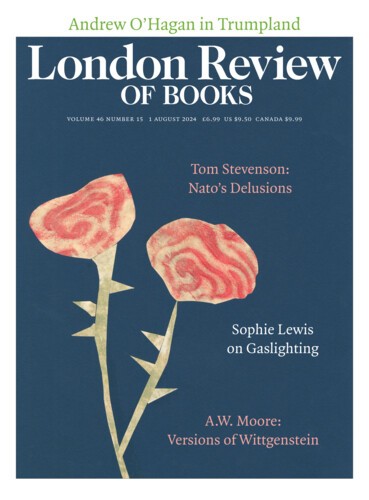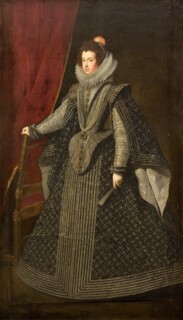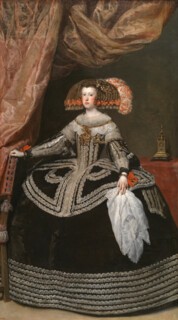Clothes have rarely mattered more than they did at the Spanish court in the 17th century. Portraits were already key to the game of sartorial diplomacy and one-upmanship. When the itinerant Charles V was struggling to establish his rule over the kingdoms of Castile and Aragon, he sent the Spanish court Titian’s copy of his portrait, originally painted by Jakob Seisenegger, in magnificent gold and white. Our image of later Habsburg kings comes largely from Velázquez: Philip IV rigid in narrowly cut black; his queens and infantas imprisoned in vast hoops and boned corsets. The title of Amanda Wunder’s book refers to these portraits, but its subject is the man who designed and produced many of the garments. Mateo Aguado was tailor to the Habsburg queens of Spain for some forty years. The details of textiles, cuts and decorations – which Velázquez’s brushwork reflected only in a summary manner – encoded specific meanings about costliness, privilege and politics both domestic and imperial. None of Aguado’s creations has survived, but Wunder sets out to recreate them from the tailor’s accounts, from those of other specialist craftspeople, and from merchants and unillustrated pamphlets describing the ceremonial dress on display at royal events.
Aguado came from a humble background. He was born in a village outside Madrid sometime around 1605. His apprenticeship may have been to his first wife’s father, a master tailor of middling success. A few years as a poorly paid journeyman in a master’s workshop would have followed, then guild exams in which, for a fee, the candidate could choose between making a garment for a man or a woman. Provided he accurately estimated the amount of fabric required and drew the pattern pieces, he was given leave to make his final work, the ‘masterpiece’. There appear to have been no women tailors, though Wunder notes that women seamstresses made the shirts that were worn under other garments. Aguado was soon spotted. He is documented working for Francisco de Soria, tailor to Queen Isabella, in the 1620s. When Soria died in 1630, his office of sastre de cámara (chamber tailor) was left vacant for the first time in almost three decades, providing the young Aguado with the chance of a lifetime.
As tailor to Isabella of Bourbon, Aguado was present for the daily ritual of dressing the queen – one of very few men allowed into her inner sanctum. This necessitated Aguado to arrange his own marriage: the position was open only to men who were ‘married and well regarded’. When his first wife died within a year, he married Bernarda Ruiz de Reinoso, the 13-year-old daughter of the king’s milliner, with whom he would go on to have fifteen children (only three of whom survived him). Also involved in dressing the queen were embroiderers, glovers, farthingale-makers, shoemakers, cordmakers and trimmings-makers. Isabella seems to have taken a close interest in her wardrobe, especially in the selection of fabrics and decorations. Wunder refers to an occasion when she stopped production of a fabric specially commissioned for her, presumably on account of its design or quality, suggesting that she may have visited the royal weavers’ workshop, just as the king visited Velázquez’s studio.
Aguado’s role in designing and making the queen’s outfits was extremely demanding. In 1631, he created 23 new three-piece vestidos (gowns) and two two-piece sayas enteras (full skirts) for formal occasions, each with its accessories and petticoats. He also designed outfits for the royal children and retinue. At any one time, he had as many as fourteen journeymen and fifty seamstresses working for him. Although he received only a modest salary (much of which went towards the pension he was obliged to pay his predecessor’s widow), he was allowed to charge for each garment. He seems to have made a good living, even after paying for materials and, like many other artists and craftsmen, having to wait years for the king to reimburse him. According to a post-mortem inventory of his estate in 1673, he owned many expensive garments of his own, as well as paintings, furniture, silver, jewellery and books.
It is to Velázquez’s portraits that Wunder turns to get a sense of what Aguado’s outfits looked like and the way they were styled. His designs had to respond to Isabella’s frequent pregnancies, Philip’s half-hearted attempts to impose sumptuary laws and, above all, endless wars. Velázquez’s first portrait of Isabella, c.1631, shows ‘dramatic developments’ in the decorations of her dress in comparison with an earlier version. Rows of straight trimming were replaced with gold thread alamares – decorative features with buttons on one end and loops on the other – that stand out against the rich black fabric. These artefacts were a favourite decoration of the military elite, appearing in the battle paintings commissioned for the Hall of Realms in Buen Retiro Palace. By 1635, Aguado was adding pricking and slashing – again associated with soldiers’ uniforms. Isabella’s new militarised look was disseminated to other European monarchies in portraits like the one at Hampton Court attributed to Velázquez and workshop, which was sent to Charles I along with portraits of Philip IV and Prince Baltasar Carlos dressed in armour.
Beneath Isabella’s dresses lay a ‘scaffolding of rigid undergarments that flattened her chest, cinched her waist and hid her legs’. These included corsets made from taffeta and whalebones, and layers of petticoats, almost always in blood-red silk – blood being one of the four bodily humours – and decorated with silver or gold thread. Cone-shaped farthingales or verdugados had been worn at the Spanish court since the late 15th century, but in the mid-1630s a new type, the outrageously wide guardainfante, became popular. The fashion originated in France, where unmarried women used it to conceal pregnancies; one critic called it ‘diabolical’. In Spain, it was said, a guardainfante could be as wide ‘as an entire street’. Thanks to its associations with France and low morals, Isabella was slow to adopt the new fashion. Constant speculation about her ability to produce a ‘spare’ male heir seems to have worn her down. The Hampton Court portrait, probably painted a year or so before she gave birth to the Infanta María Teresa, shows her in a guardainfante. Over it, she wore a quilted pillow for the hips, designed to avoid chills to the uterus that were believed to make it ‘inept for reproduction’.
Another fashion from France was the low-cut bodice or escotado. In 1636, Marie de Bourbon, a distant cousin of Isabella’s and wife of one of her husband’s allies, arrived at the Spanish court. She appeared at public events including bullfights and Corpus Christi festivities, and her revealing necklines and slim skirts – by then farthingales were no longer fashionable in France – made her an object of fascination. But it was the arrival at the end of the following year of the bewitching Marie de Rohan, duchess of Chevreuse, which convinced the ladies of the Spanish court to reveal their décolletage. (Wunder rejects the suggestion that Velázquez’s Lady with the Fan at the Wallace Collection is Chevreuse, noting that she is wearing a type of skirt not fashionable for another decade.)
In the early 1640s, Isabella’s look started to change again, this time to reflect her new role as regent of Castile while Philip campaigned against the Catalans. By 1643, when she was in mourning for her brother, Louis XIII of France, her dresses were mainly black, with black trimmings rather than silver or gold. A year later Isabella herself died, her last outfit a habit of the Poor Clares provided by the nuns at the convent of Las Descalzas Reales. Aguado became sastre de cámara to the royal children, María Teresa and Baltasar. They had barely emerged from mourning when the prince caught smallpox and died, making it imperative for the monarchy to produce a replacement male heir. The 11-year-old Mariana of Austria, who had been engaged to the unfortunate Baltasar, was now offered to Philip. In 1649, Aguado went to the Valencian port of Denia to meet her ship with a garment bag containing a dress, cloak and farthingales. His role was to ensure that the Austrian princess was already dressed as queen of Spain when she set foot on Spanish soil.
Velázquez’s first portrait of Mariana (Mariana in Black and Silver at the Prado) was painted in 1652, after she had recovered from the birth of Margarita, her first child. Aguado designed for her a skirt so wide that Velázquez had to add a strip of fabric to the left-hand side of the canvas. Her wig, also designed under Aguado’s supervision, was decorated with bows, gold ornaments, plumes and a brooch, echoing the shape of the guardainfante. The following year he painted María Teresa in an almost identical outfit and wig. Either Aguado was repeating a trusted formula or Velázquez used the same template (which he often did for the royal portraits). This portrait, now at the Kunsthistorisches Museum in Vienna, was sent to the Emperor Ferdinand – one of several versions sent to other courts as part of her marriage negotiations.
Aguado also designed clothes for the Infanta Margarita. Best known is the one she wears in Las Meninas, painted in 1656, the year of her first public audience. The dress, also worn in a portrait sent to Ferdinand, was one of her first ‘mature’ dresses (at five years old), consisting of a guardainfante and doublet. Here, as elsewhere in the book, Wunder turns to Velázquez’s paintings for her analysis. Although his famously quick brushwork ‘elided and eliminated decorative details’, the portraits give us a more penetrating understanding of the image that the Spanish monarchy wished to convey than any textual description supplied by accounts or pamphlets. The portraits reveal the paralysing isolation imposed by the garments, and why the rituals of dressing and undressing took up so much of the queen’s day. As Aileen Ribeiro puts it in Clothing Art (2017), Velázquez ‘captured the essence of dress’, ignoring mundane details. (This struck me again at the Sargent and Fashion exhibition at Tate Britain this year, where the preserved garments seemed lifeless compared to their representation on canvas.)
Velázquez died in 1660, Aguado in 1672. Aguado was quickly forgotten while Velázquez’s celebrity only grew, largely because painting was regarded as the higher endeavour. Painters were winning the battle for recognition as practitioners of the liberal arts, but tailors remained craftsmen, and had a reputation for cheating customers by overestimating the cost of materials. The various turns in art historical theory and criticism along with democratisation and decolonisation of museum displays mean that few people hold with such hierarchies in quite the same way. Appreciation of Aguado’s artistry and his role in translating the political imperatives of his employer is long overdue.
Send Letters To:
The Editor
London Review of Books,
28 Little Russell Street
London, WC1A 2HN
letters@lrb.co.uk
Please include name, address, and a telephone number.



